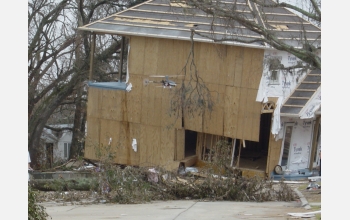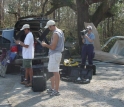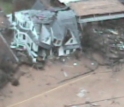News Release 05-160
Small, Unmanned Aircraft Search for Survivors in Katrina Wreckage
Hurricane search and rescue is one of first domestic uses of such vehicles

An unmanned aerial vehicle searches for Hurricane Katrina survivors in Pearlington, Miss.
September 14, 2005
B-roll is available.
This material is available primarily for archival purposes. Telephone numbers or other contact information may be out of date; please see current contact information at media contacts.
Providing the benefits of speed, portability and access, a pair of unmanned aerial vehicles (UAVs) surveyed storm-damaged communities in Miss. as part of the search for trapped survivors of Hurricane Katrina.
In what is one of the first deployments of such craft for disaster search and rescue, the vehicles captured video imagery to help responders focus efforts and avoid hazards.
"The two UAVs packed a one-two punch," says Robin Murphy of the University of South Florida (USF) and director of the NSF-supported Center for Robot-Assisted Search and Rescue (CRASAR). "The fixed-wing provided a quick overview of an area over several miles, but the use of the miniature helicopter to hover by buildings and on roofs--and to takeoff straight up--really offers new functionality."
Florida emergency responders surveying Pearlington, Miss., asked the Safety Security Rescue Research Center (SSRRC) team to respond to reports of floodwater-stranded survivors. Murphy led the effort with other members of the SSRRC, an NSF-supported industry-university partnership among USF, the University of Minnesota and numerous defense and advanced technology companies.
Although houses pushed into the street during the storm surge blocked the entrance into Pearlington, the unique capabilities of the UAVs allowed the team to launch the aircraft from an open patch of road surrounded by downed trees and power lines.
One of the UAVs is a 4-foot-long airplane with mounted video and thermal imagery cameras that can capture details from as far away as 1,000 feet. Launched by hand, the craft provides rescuers with a broad overview of the disaster area. In part because of the ease of launch and minimal, five-car-length distance needed for landing, the fixed-wing UAV is much easier to deploy than its full-scale counterpart.
The same holds for the other UAV, a camera-equipped, miniature, electric helicopter called a T-Rex. Provided by SSRRC partner Like90, the helicopter can hover at heights approaching 250 feet and zoom its camera to peer inside windows or scan distant rooftops.
Within 2 hours, the vehicles provided responders with information showing that no survivors were trapped and the floodwaters from the cresting Pearl River did not pose an additional threat.
The vehicles are but two of many land- and aircraft operated by SSRRC, one of more than 40 NSF Industry - University Cooperative Research Centers (I/UCRCs). NSF provides a small investment to universities to start the centers, and industry partners bring additional investment and collaboration. NSF then maintains a supporting role with each center as it evolves over a period of up to 10 years.
According to Rita Rodriguez, program officer for Computing Research Infrastructure at NSF and one overseeing the center, SSRRC combines research efforts in robotics and robotic vision and involves not only industry, USF and UMN, but also undergraduate-focused colleges, such as Augsburg College in Minneapolis, Minn., and Berea College in Berea, Ky.
-NSF-
-
Mike Lotre, John Dugan and Robin Murphy monitor the UAVs during their deployment.
Credit and Larger Version -
View Video
A UAV captured this image of devastation in Pearlington, Miss., following Hurricane Katrina.
Credit and Larger Version
Media Contacts
Joshua A. Chamot, NSF, (703) 292-7730, email: jchamot@nsf.gov
Randolph Fillmore, University of South Florida, (813) 974-8476, email: Rfillmor@admin.usf.edu
Program Contacts
Rita V. Rodriguez, NSF, (703) 292-8950, email: rrodrigu@nsf.gov
Alex Schwarzkopf, NSF, (703) 292-5359, email: aschwarz@nsf.gov
Principal Investigators
Robin Murphy, University of South Florida, SSRRC, CRASAR, (813) 974-4756, email: murphy@cse.usf.edu
Related Websites
USF Press Release: http://usfnews.usf.edu/page.cfm?link=article&aid=1053
The U.S. National Science Foundation propels the nation forward by advancing fundamental research in all fields of science and engineering. NSF supports research and people by providing facilities, instruments and funding to support their ingenuity and sustain the U.S. as a global leader in research and innovation. With a fiscal year 2023 budget of $9.5 billion, NSF funds reach all 50 states through grants to nearly 2,000 colleges, universities and institutions. Each year, NSF receives more than 40,000 competitive proposals and makes about 11,000 new awards. Those awards include support for cooperative research with industry, Arctic and Antarctic research and operations, and U.S. participation in international scientific efforts.
Connect with us online
NSF website: nsf.gov
NSF News: nsf.gov/news
For News Media: nsf.gov/news/newsroom
Statistics: nsf.gov/statistics/
Awards database: nsf.gov/awardsearch/
Follow us on social
Twitter: twitter.com/NSF
Facebook: facebook.com/US.NSF
Instagram: instagram.com/nsfgov




